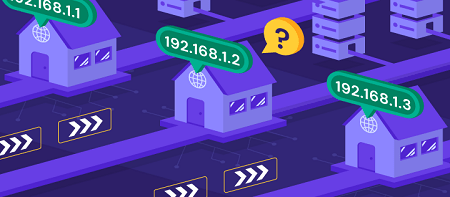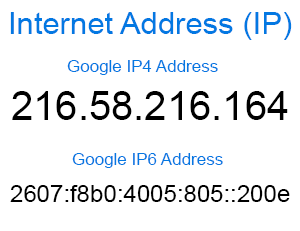Why has my IP address changed
IP Address: Internet Protocol address, in short form, is known as IP address. This address could pose security liability, and these addresses are building blocks of the internet. IP addresses are mathematically produced by the IANA (internet assigned numbers authority), a division of the ICANN (internet corporation for assigned names and numbers). ICANN was established in the United States in 1998 to allow the internet to be used by all people, and it is a non-profit organization.

An IP address is made up of numbers as well as strings. Periods of separation will be there in these addresses. These numbers string is attached to the devices which use IP addresses. We can express each address as four numbers set.192.168.1.2 can be taken as an example. The range is 0 to 255. 0.0.0.0 to 255.2555.255.255 is the full IP addressing range.
These Internet Protocol addresses can be called identifiers because they are unique. It is specified to a particular device only. Can know the information and send the information by using these addresses through computers. The passing of information between different devices is possible. Contain location information of particular devices. They provide a way to do work. It is a unique address. The other thing about IP addresses is they are not random. As these addresses are unique, it identifies whether it is on the local network or another.
IP Addresses Versions
IPv4 and IPv6 are the two versions of IP addresses.
Ipv4: IPv4(Internet Protocol version 4) addresses are written in four parts, and these four parts are separated by dots. Let us understand the IPv4 address by an example. Example: 45.48.241.198. In this version, we can see the dotted decimal notation, network prefix and host number are parts of this version and contains 32-bit numbers. These addresses cannot be more than 255 (111111 – binary number of 255).
As computers fundamentally deal with numbers in binary form, these addresses, that are written in standard decimal notations, are converted into binary numbers. The length of each header field is twenty, and the total number of header fields is 12 in IPv4 addresses. Unicast, broadcast, and multicast are the styles of IPv4 addresses. With this version of addresses, we can keep this more secure and private as these addresses encrypt data. Gives security measures by using its addressing packets
The process of routing becomes more efficient in IPv4 because addresses are combined more efficiently. This version's IP address is also more secure. There are five classes in IPv4 addresses, and they are identified by the first octet of the IP address. The IPv4 addresses were going out to run because of the development of the IPv6 version. But still, IPv4 addresses are widely used.
IPv6: IPv6(Internet Protocol version 6) addresses are 128-bit numbers; 128-bit numbers mean that there are two power 128 possible addresses which is a thirty-nine-digit long number, and this thirty-nine-digit long number is called undecillion, which means it allows 3.4 x 10 6 38 addresses approximately. This IPv6 version is the most recent version, which dominates the IPv4 address.
These addresses have 16-bit numbers or fields. Each field in this IPv6 address is bounded by a colon, and also each field should contain a hexadecimal number too. The range of IPv6 addresses is from 0000:0000:0000: 0000:0000:0000: 0000:0000 to ffff: ffff: ffff: ffff: ffff: ffff: ffff: ffff. IPv6, also known as IPng. The predecessor of IPv6 (Internet Protocol version 6) is IPv4 (Internet Protocol version 4).
These IPv6 addresses contain three parts or elements are global routing prefix, a subnet ID and an interface ID. There are eight fields in the Internet Protocol version 6 address, which is in contrast to the Internet Protocol version 4. ISP is also involved in providing and organizing the addresses uniquely.
The main differences between these two versions are it is possible to create unique IPv6 addresses 2^128 than IPv4 addresses 2^32. IPv6 is an alphanumeric addressing method, while IPv4 is a numeric addressing method. The IPv4 addresses contain checksum fields. The binary bits in IPv6 are separated by a colon, whereas in IPv4 addresses, the binary bits are separated by a dot. The IPv6 have a simpler head format. It is more efficient in routing when compared to IPv4 addresses. IPv6 is more secure, and we can share files easily.
How does An IP Address work?
IP addresses are unique, and they check whether the device is receiving what has been sent correctly or not, so they can compare with SSN (Social Security Number). Letters have been added to some addresses as internet usage grows. But most IP addresses are purely numerical in starting. For delivering to the address, they need a router. The reason why computers send and receive data over the internet is because of IP addresses. The establishment of the connection is done with the help of routers. We can appreciate the work of IP addresses in the way they are working uniquely and sending the correct information on the internet. These IP addresses' work is almost similar to post office work. The way they are created affects their work very much to work efficiently.
Let us know about four types of addresses.
They are:
- Public Internet Protocol address
- Private Internet Protocol address
- Static Internet Protocol address
- Dynamic Internet Protocol address
Public Internet Protocol Address: This IP address is used outside of a network, as the name indicates.
Private Internet Protocol Address: This IP address is used inside of a network, as the name indicates.
Private Internet Protocol addresses and Public Internet Protocol addresses are both indicative of the location of the network.
Static Internet Protocol Address: A static IP address is manually created, not unlike other IP addresses (like private, public and static). It opposes being assigned.
Dynamic Internet Protocol Address: DHCP assigns a dynamic internet protocol address. DHCP (Dynamic Host Configuration Protocol). And these addresses are supposed to change.
Dynamic Internet Protocol addresses are also known as common IP addresses, as they are most people use them. These dynamic IP addresses will expire over time, and they are active only for a certain amount of time.
Both dynamic and static indicate permanency.
Why has my IP address changed?
ISP (Internet Service Provider) provides Internet Protocol addresses; we know very well about this thing. If we create or set up an account, they directly assign IP addresses to us. To install the connection, this ISP directly visits our home to install the connection. To everything work well, the IP address plays an important, vital and major role. Because from the day starting to the end of the day, we use the internet to do all our important work.

To all these works well, we need internet and IP address plays a major role in the background. If this internet does not work the way it has to work, we have to work with our ISP’s technical department to get everything corrected. At a time, thousands and thousands in particular areas, and millions and millions around the world, computer devices, mobile or handled devices work at a time. And everything is interconnected. According to our users, we use the internet. If we do work most of the time, we use the internet or else we just use it for a few minutes. Sometimes our IP address will change, but most of the time, we will find that our IP address will not change.
Let us know a few reasons why our IP address changes:
When connecting to the internet with broadband, we are given a static Internet Protocol address, and this address will be the same each time. We need a broadband internet connection to use a static internet protocol address. But sometimes, this address will change. For every fourteen days, there is a DHCP lease renewal. Sometimes we will be assigned to previous connections if we connect to the internet each time using a modem.
Below are a few reasons why our IP address has changed.
- If the given DHCP lease time to our IP address has expired, the IP address will change.
- Internet Service Provider changes the router or centre is responsible for address.
- ISP has pointed out a network failure causing rebuilding of routing tables of routers.
Setting a Static IP Address
There are many reasons that we may need to change and set a static Internet Protocol address for our IP device. By setting static IP addresses, we can avoid network conflicts. As static IP address works to advance the functioning of the network, we will have great advantages by using it.
Steps need to follow
- Access the control panel
- Select the Network Adapter
- Select Properties
- Select internet protocol version 4(IPv4)
- Enter IP address and subnet mask and then save settings
- Revert Back to DHCP